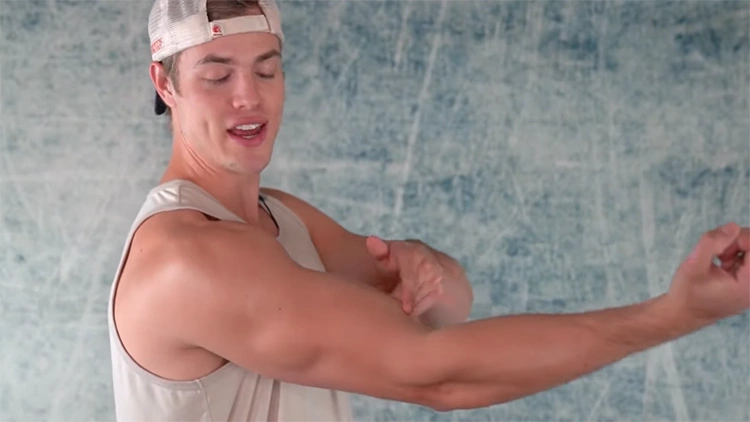
Bad arm genetics is typically characterized by poor insertion points, disproportionate bone structure, and uneven muscular proportions. This can be seen in both poor tricep genetics and poor bicep genetics.1
It could be considered poor arm genetics if the arms are less than the ideal proportions or if they match the small measurements according to the Reeves’ proportion chart.
The pictures, descriptions and proportion charts below serve to help anyone determine if they have poor bicep genetics
oor arm genetics and potentially poor bodybuilding genetics, or if it’s something else like a lack of volume and intensity.
But if you happen to have less than desirable arm genetics don’t worry or treat it like a plague because plenty of professional bodybuilders and casual gym goers alike have overcome poor arm genetics using the pointers discussed here. Or in other words, lackluster arm genetics don’t have to be a career ender, slow down your gains or be a blow to your self-esteem; but it does mean you’ll have to work a harder than others to see similar results and train intelligently by using the methods below.
What Does It Mean To Have Bad Arm Genetics?
To understand what it means to have poor arm genetics, one must first understand what a muscle insertion is.
A muscle insertion is basically where the tendons of a muscle meet the bone. The further down the bone the tendon attaches, the greater the mechanical advantage the muscle will have – meaning that it can produce more force and overall, develop more muscle.
So, if we take the biceps brachii for example, those with long muscle insertions will have a greater mechanical advantage and will be able to curl more weight than those with shorter insertions. This is why some people seem to be able to curl much more weight than others – they simply have better arm genetics in terms of their muscle insertions.
Interestingly enough, there are some genetic anomalies that have a third bicep head; this would certainly be considered a mechanical advantage.2
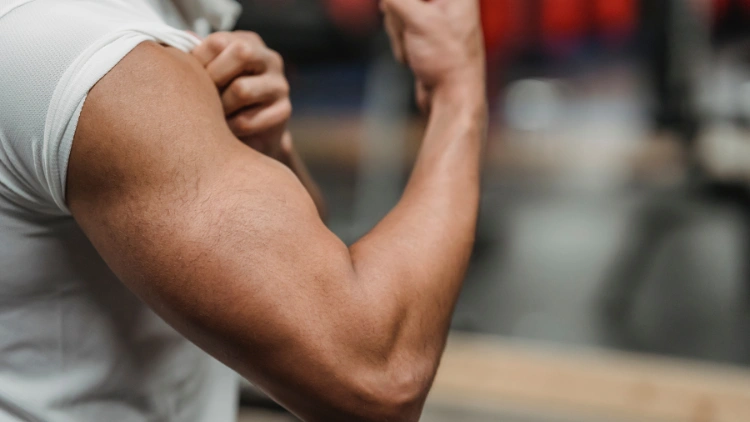
Source: Julia Larson via Canva.com3
That being said, muscle insertions describe where the muscle is inserted into its respective joint. Back to the bicep, the bicep inserts into the elbow; the further away from the elbow the insertion is, the shorter the muscle belly will appear, and vice versa.
Those with shorter muscle insertions will have a smaller range of motion and won’t be able to curl as much weight as those with longer insertions. This is why some people seem to have “bad arm genetics” – they simply don’t have the muscle insertions to allow them to lift a lot of weight.
There are quite a few other factors that can play into a person having poor arm genetics. One type of poor arm genetics that quite a few people discuss is asymmetrical arms.
Having asymmetrical arms is quite intuitive to understand – the arms are not the same size. This may mean that a person’s biceps are not the same size or are shaped differently; on the other side of the arm, a person could have slightly different tricep attachment that could lead to an imbalanced-looking physique.
Bicep and tricep peaks are the other main type of poor arm genetics. The overall ‘peak potential’ is determined by the individual’s muscle insertion location, but a lifter can also have a peak that is flatter than their other arm, or even has muscle fibers missing that lead to a gap in their arm.
This is most commonly seen in the bicep, where one arm has a rounded peak, while the other has an odd shape. Further along in this article, some pictures of uneven bicep peaks will be discussed.
Other factors play into arm size as well, such as bone size and overall body proportions. Regardless, muscle insertions are the primary factor that determines how much weight someone can lift.
Even still, it is extremely difficult to control for genetics; in one study conducted on mice, there were over 40 genes that reportedly modulated the amount of muscle hypertrophy.4
How To Know If You Have Bad Arm Genetics
Determining if an individual has poor arm genetics can sometimes be difficult to determine. For example, for the triceps, the main way to determine if a person has poor arm genetics is by visually looking at the triceps to see where the muscle insertion is on one arm and comparing it to the other.
Using a tape measure to see if the triceps are of a similar size and length can be helpful to see if there is asymmetry here.
The biceps, on the other hand, have a specific test to see how long the muscle belly is. This is discussed at length in our article on poor bicep genetics, but to sum it up, hold an arm up and flex the bicep.
Place a finger in between the end of the bicep and the elbow, and see how many more fingers can be added. Most people who perform the bicep insertion test believe that any more than two fingers fitting in the gap means that a person has a short bicep.
Similar to the tricep, a tape measure can also be used on the bicep to see if the biceps are of a symmetrical size. Taking a picture while flexing both arms and comparing the proportions of each arm would also be a good idea here – if, visually, there is clearly a difference in size or shape between the two arms, this would mean that they are asymmetrical.
But, the easiest way to determine if a person has poor arm genetics is to use a classic bodybuilding proportion chart, which is a bit different than determining bad chest genetics, bad shoulder genetics, or bad ab genetics. This gives a good idea of where people’s arms fall in terms of size relative to the rest of their bodies. Meaning, if they are this small, then a person might have bodybuilding genetics.
There are a wide variety of proportion charts that exist, but the most popular one is the Reeves proportion chart. This chart was created by Steve Reeves, a bodybuilding legend from the 1940s and 1950s.
He is revered for having nearly perfect, if not perfect, proportions, with his muscular aesthetic being regarded as a benchmark to aim for when it comes to symmetry for someone trying to mimic his physique; effortlessly shedding weight and avoiding junk food and sugar is important.
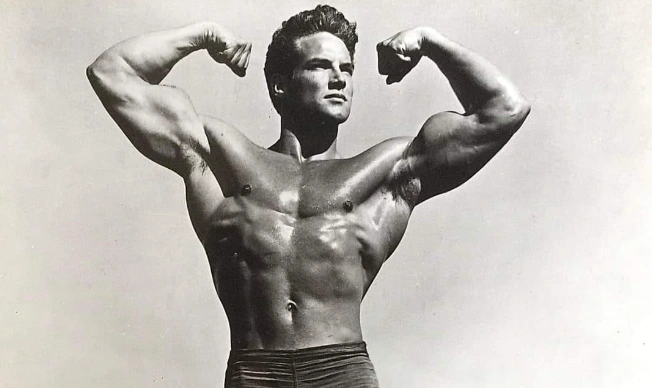
It’s evident here that his body achieved the ideal type, perfectly proportioned physique. Source: @steevereeveshercules on Instagram5
Take a look at this picture of him. He achieved many ideals through his physique – the classic V-taper, where the shoulders are somewhere around 1.5 times wider than the waist, symmetrical arms and forearms, and proportional legs.
To determine where a person falls on the Reeves proportion chart, take a peek at the standards below:
- Arm size = 252% of wrist size
- Calf size = 192% of ankle size
- Neck size = 79% of head size
- Chest size = 148% of pelvis size
- Waist size = 86% of pelvis size
- Thigh size = 175% of knee size
So, for example, to calculate what a person’s chest size should be, they need to first measure their pelvis. After doing so, multiplying that number by 1.48 will result in how large their chest should be.
The unique idea about the Reeves proportion chart is that it is solely based on bone size; all of the variables that are being multiplied by the size of bones. Wrist size, ankle size, head size, pelvis size, and knee size – these are genetic things that cannot be changed (but bone density and strength over time are positively impacted by vigorous exercise).6
This allows the chart to be more standardizable than others, and intuitively, it makes sense why this may make an aesthetically pleasing physique; if Steve Reeves, one who many consider highly aesthetic, was around these numbers, it would be assumed that someone who shares similar proportional aesthetics to him would also look good.
Reeves also recommended a standardized weight based on height:
- 5’5″ 160lbs
- 5’6″ 165lbs
- 5’7″ 170lbs
- 5’8″ 175lbs
- 5’9″ 180lbs
- 5’10” 185lbs
- 5’11” 190lbs
- 6’0″ 200lbs
- 6’1″ 210lbs
- 6’2″ 220lbs
- 6’3″ 230lbs
- 6’4″ 240lbs
- 6’5″ 250lbs
For example, if a person is 6 feet tall and weighs 210 pounds, they would fall into the “ideal” range for both height and weight. However, if they are 6 feet tall and weigh 230 pounds, they would be considered overweight according to the Reeves proportion chart.
There are other proportion charts out there, but the Reeves chart is the most widely used and recognized, so it’s a good starting point to determine if a person has poor arm genetics or not.
Poor Bicep Genetics vs Excellent Bicep Genetics With Pictures & Descriptions
Just like any other muscle group, the biceps can vary widely in terms of size and shape. Some people are blessed with excellent bicep genetics that allows them to build big, strong arms, while others have poor bicep genetics that makes it difficult to add size and strength.

The left image, the guy in yellow shows poor bodybuilding genetics while on the right, the guy in red, shows good bodybuilding genetics. Source: musclemonsters on Youtube7
There are a few key factors that contribute to good or poor bicep genetics. These include:
- Muscle insertions
- Bone structure
- Body proportions
Let’s take a closer look at each of these factors and how they can impact a person’s ability to build bigger biceps.
Bad: High Bicep Insertions
One of the most common characteristics of poor bicep genetics is high bicep insertions. This means that the biceps attach higher up on the shoulder than average, which can make it difficult to add size and strength.
Those with high bicep insertions will have a smaller range of motion and won’t be able to lift as much weight as those with low bicep insertions. This is because the leverage is not in their favor.
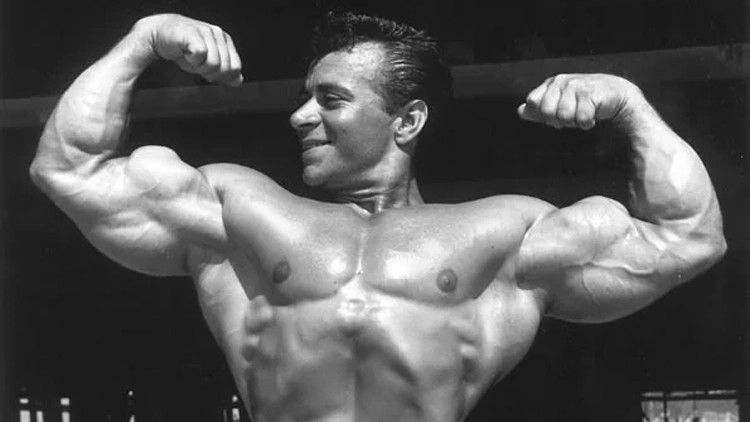
Despite his impressive physique, take note of his high bicep insertions. Source: u/AirmanElmo on Reddit8
In this example above, this bodybuilder has an impressive physique, but pay attention to the biceps.
Between the elbow and the end of the bicep muscle belly, there is an easily discernible gap where a person could fit a few fingers. This is what a short bicep, or a high insertion bicep, looks like.
High bicep insertions are genetic and cannot be changed. However, there are some exercises that can help offset the disadvantage, such as preacher curls and hammer curls; these target the brachialis which sits underneath the bicep, helping to develop a fuller-looking arm than one could develop by focusing solely on the bicep itself.
Good: Low Bicep Insertions (‘Long’ Bicep)
Low bicep insertions are the opposite of high bicep insertions. This means that the biceps attach lower down on the arm, which gives you a longer lever arm and more potential for size and strength gains.
Those with low bicep insertions will have a greater range of motion and be able to lift more weight than those with high bicep insertions. There is overall more room for the muscle to develop, and while a low bicep insertion offers the ability to create ‘fuller’ looking arms, those with long biceps will tend to have less peaky biceps than those with short biceps.
This picture is a good example of excellent bicep genetics.
As one can see, the end of the bicep reaches nearly all the way to the elbow, allowing for the arm to look completely filled out. While a shorter bicep would technically afford Larry Scott, the bodybuilder pictured, a higher peak, most would prefer the overall look a long bicep offers.
Bad: Uneven Biceps
Another common characteristic of poor bicep genetics is uneven biceps. This means that one bicep is significantly larger than the other, which can make it difficult to add size and strength evenly.
Uneven biceps are often caused by imbalances in the muscles or nervous system. This can be due to injury, but more often than not, it is genetic.
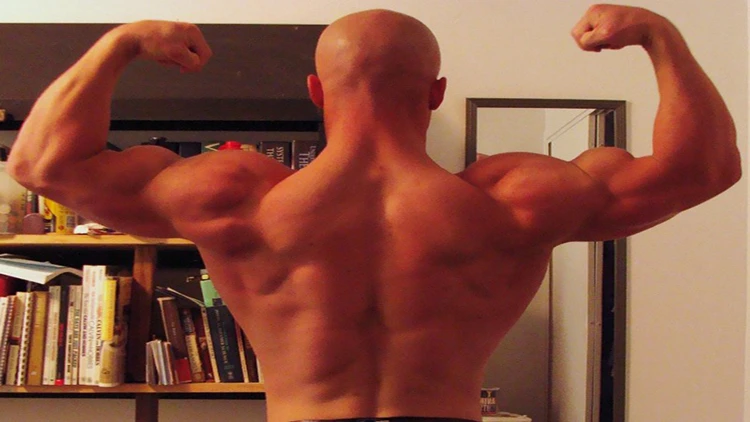
This guy’s right bicep peak is significantly taller than the left. Source: @jonnyp on the Anabolic Minds Forum9
The above picture makes it a little bit difficult to discern which bicep is larger than the other due to the lighting, but taking a closer look at the right bicep, it should be quite clear that there is an overall higher peak than the left bicep. While this man clearly has done proper training, it may be genetics that has led to him having uneven biceps.
Adjusting training based on uneven biceps is difficult because one may require more repetitions and sets to get a similar training stimulus to the other; using the Reeves proportion chart to determine if one arm is lagging behind the other is useful, in this event.
Good: Symmetrical Sizes
Symmetrical biceps are the opposite of uneven biceps. This means that both biceps are approximately the same size, which makes it easier to add size and strength evenly.
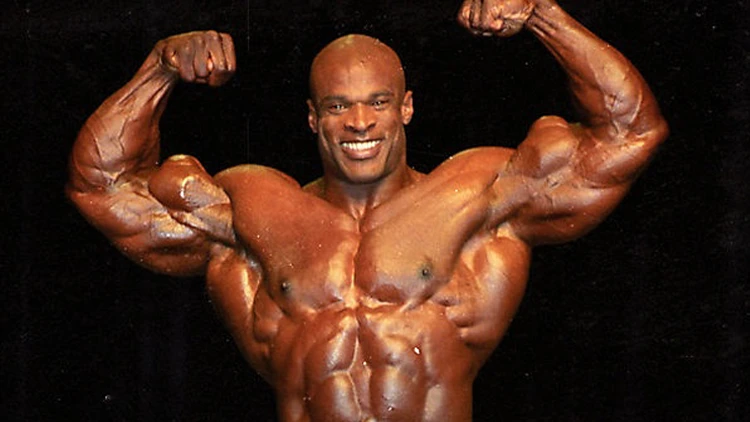
Take note of the symmetry of his biceps and leaving a space no wider than a few fingers between his elbow and biceps. Source: u/AlexBC13 on Reddit10
Symmetrical biceps are often genetic, but they can also be the result of training both sides evenly. This is why it’s important to focus on compound exercises that work both biceps equally, such as chin-ups and rows.
To reiterate information that has already been discussed, Ronnie Coleman, pictured above, has symmetrical biceps, but also has biceps that are on the shorter side – they have a relatively high peak, and have a few-fingered gap between the elbow and the bicep.
Bad: Uneven Bicep Peak
Another common characteristic of poor bicep genetics is an uneven bicep peak. This means that one bicep has a higher peak than the other, or the peak itself is uneven. This may appear as a peak that has multiple peaks, where the traditional ‘peak’ is shorter than other parts of the bicep.
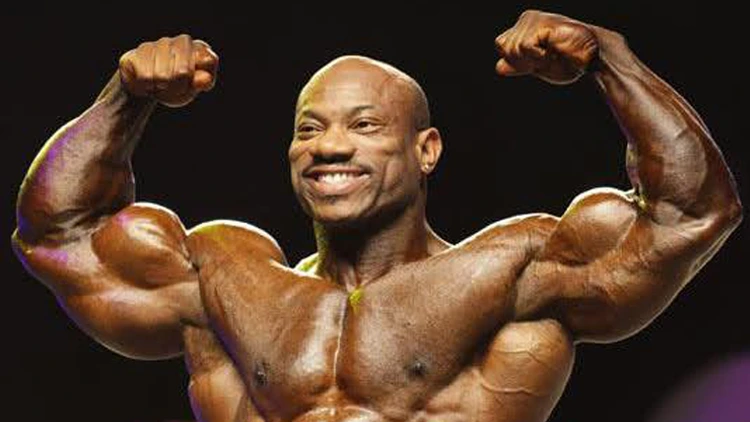
Notice the difference in his bicep peaks. Source: u/GiGoBB on Reddit11
The picture above shows what is being talked about clearly. The bicep on the left of the picture has a peak that ramps up from the left and right, while the other bicep has a smooth curve that builds up to a lower peak.
This is yet another aspect of bicep training that deals with the genetic lottery – if a person has an oddly shaped bicep peak, all they can really do is train and hope that their bad arm genetics are not that recognizable.
Good: High Peak
A high peak is the opposite of an uneven bicep peak. This means that both biceps have a symmetrical, well-defined peak.
High peaks are often genetic, but they can also be the result of training both sides with movements like the bicep curl and spider curl due to their ability to focus on that part of the bicep.
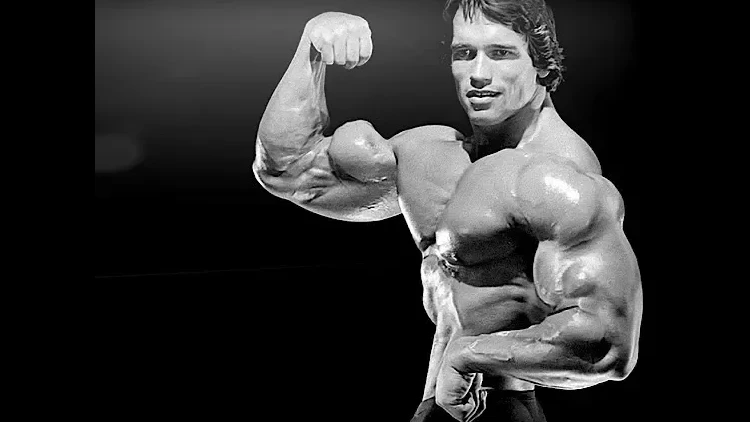
Arnolds bicep peaks are unparalleled and while he earned each pound of muscle, he also had great bodybuilding genetics. Source: King Fitness on Youtube12
This picture of Arnold in his prime is a good example of a high, even peak, at least on one arm; it is clearly defined and is not uneven in the slightest. He is a prime example of fantastic bodybuilding genetics; some could say he has bad arm genetics due to him having a slightly higher muscle insertion, but other than that, it is difficult to say that he is genetically disadvantaged in any way.
What Is the Typical Bicep Size? (Typical Bicep Size)
“What is the typical bicep size by height” is an extremely popular question among those looking to improve their arms. There has, however, been no actual research conducted on this topic yet; everything we know comes from anecdotal evidence and speculation.
However, there is information that exists about bicep size by age.
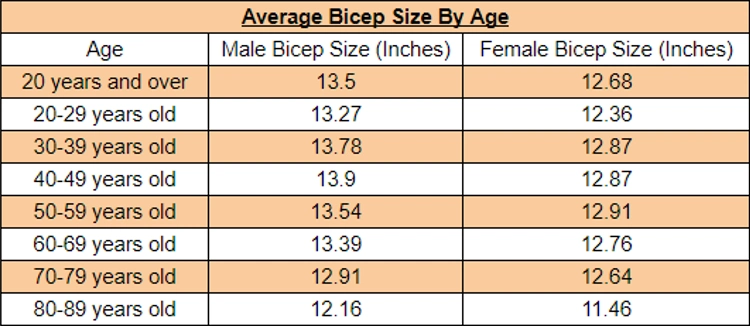
The CDC did release the above data from 2011-2014 that offered some insight into what the typical bicep size by gender and age is, but not by height. We can assume that people with larger skeletons will be able to build more muscle in general, but we don’t know how that affects specific areas like the biceps.
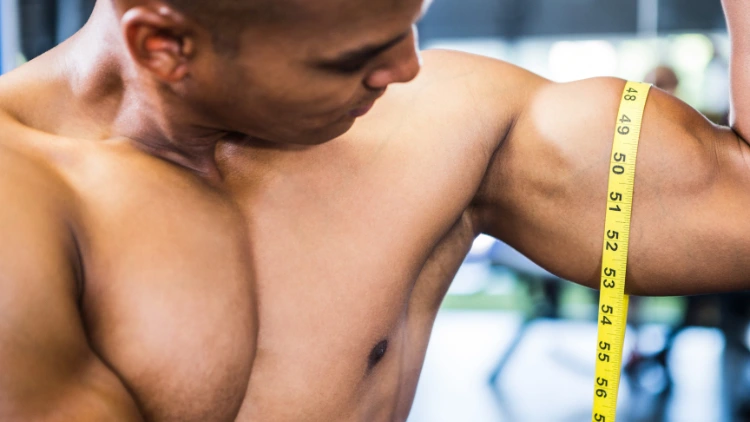
Source: Wavebreakermedia via Canva.com13
With this in mind, we should consider what other factors contribute to the maximum bicep peak. We need to examine how altering the insertion point of the bicep affects its average size and how varying genetic levels influence the peak.
There are numerous factors that affect bicep size, making it hard to form a study with concrete evidence on the typical bicep size relative to height. In less complicated terms, nobody has been able to accurately calculate the typical bicep size based on height alone because it is such a difficult task.
But, there is some relevant research that shows that there is a dose-related response to bicep growth, though unrelated to height.
This study was conducted on 49 experienced resistance-trained men.14 It established that doing 14 sets of biceps training per week is more effective than doing less for building 1RM strength and size.
Also, movements like the bicep curl that target the bicep specifically will be significantly more effective for growth than movements that only partially target the bicep, like deadlifts.
Short vs. Long Triceps: Is a High Tricep Attachment or a Low (Short Tricep) Insertion Better?
Long triceps have a lower insertion point, while short triceps have a higher insertion point. Both have their advantages and disadvantages.
Long triceps have a longer lever arm, which gives them more potential for size and strength gains.
Aesthetically, most people perceive them as more pleasing than short triceps, as well. This is because they offer the arm a much fuller look, where the tricep is attached closer to the elbow and gives the entire upper arm a much beefier look.
Short triceps, on the other hand, lead to a semi-asymmetrical appearance, where part of the arm has ample thickness, but closer to the elbow, it thins out significantly. While a short tricep offers the benefit of developing more thickness because the muscle belly is ultimately shorter, and thus must expand upwards, the shortness leads to many people preferring a low tricep attachment.
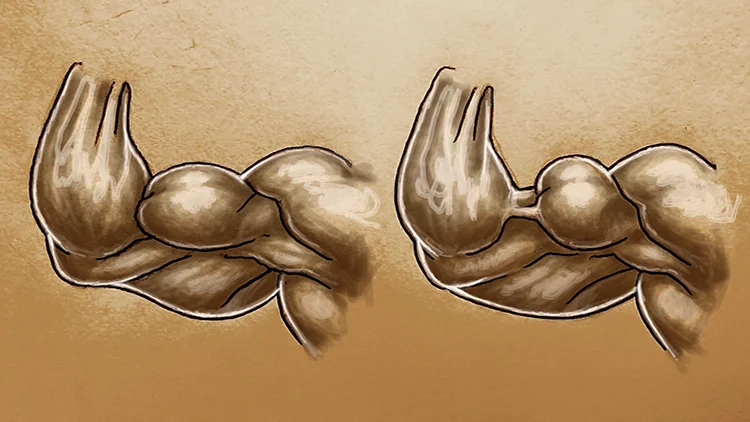
Short tricep on the left, and long tricep (preferred) on the right. Source: u/Chicken_Mcfugget on Reddit15
The differences can clearly be seen in the picture above.
On the left, there is a short tricep that is inserted higher up on the arm, closer to the shoulder, and on the right, there is a long tricep that is inserted closer to the elbow. While the short tricep has a higher overall peak, the long tricep does give the arm a fuller, more well-rounded look.
What Are Poor Tricep Genetics vs Excellent Tricep Genetics? (Good vs Poor Tricep Genetics)
There is a lot of debate on what constitutes as good or poor tricep genetics. However, there are some common characteristics that are generally agreed upon.
Bad: High Tricep Inserts
High tricep inserts are a common characteristic of poor tricep genetics. This means that the triceps muscle attaches higher up on the humerus bone, close to the shoulder.
This can lead to a number of disadvantages, such as a shorter lever arm and less potential to lift. This is mainly due to the fact that there is, as aforementioned, less overall muscle to develop by default.
This doesn’t mean it is impossible to get big triceps while having a high tricep attachment; it is just a bit more difficult.
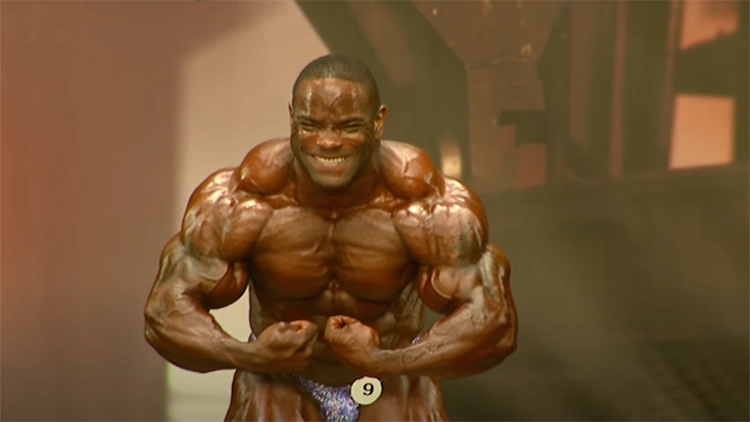
Check out how short his tricep looks and where it connects in regards to his shoulder and elbow. Source: Best Body Nutrition on Youtube16
The picture above shows this very clearly: the tricep is inserted closer to the shoulder, thus, giving the muscle a high peak, but doesn’t symmetrically cover the arms as well as a low insertion does.
Good: Long Triceps (Low Tricep Attachment)
Long triceps are the opposite of high tricep inserts. This means that the triceps muscle attaches lower down on the humerus bone, closer to the elbow.
This gives the triceps a longer lever arm and thus more potential for size and strength gains.
Aesthetically, most people perceive them as more pleasing than short triceps, as well. This is because they offer the arm a much fuller look, where the tricep attaches closer to the elbow and gives the entire upper arm a much beefier look.
Bad: Poor Tricep Head Balance
If the tricep heads are not balanced, it can lead to a number of disadvantages.
For one, it can make the triceps look uneven. It can also make it difficult to develop the triceps evenly, as some heads may grow faster than others.
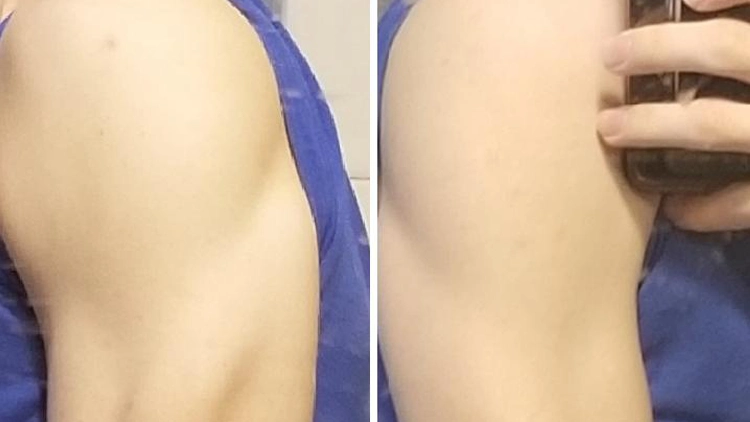
Note how his tricep lateral head is popping out on the left image (his left arm) but his long head and medial head aren’t very noticeable in either and the image on the right (his right arm) shows way less development overall. Source: u/cowboyfromhell06 on Reddit17
For example, if the long tricep head develops more slowly than the lateral or medial heads, the arm will look much thinner from a profile view. While one’s arm may be wide, the lack of front-to-back thickness can contribute to abnormally balanced arms, throwing a person off if they are aiming for proportional muscles.
If they are this small, body bodybuilding genetics may be at play.
Good: Symmetrical Tricep Heads
Symmetrical tricep heads are generally seen as excellent tricep genetics. This means that all three tricep heads – the long head, the medial head, and the lateral head – are of proportional size across both arms.
The long head will generally be larger, because it is the largest of the three heads, while the medial head will be the smallest. The medial head is generally trained less than the other heads due to the kind of training that is required to target it.
Regardless, including training for all three heads of the triceps will allow it to develop a more balanced and aesthetic appearance.
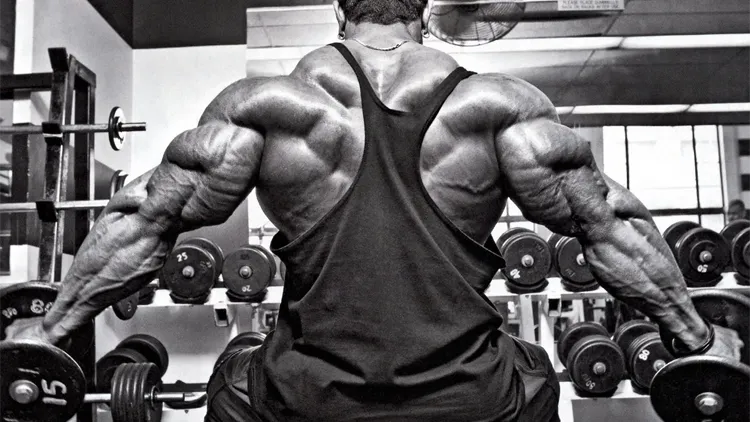
Roelly’s well-developed physique, especially his triceps. Source: u/albertzz1 on Reddit18
This picture shows well what well-developed triceps look like from the back; the long head is accentuated for the most part, while the lateral head beefs up the density of the upper arm, and the medial head can be seen feeding into the elbow joint near the forearm muscle.
Overcoming Poor Bodybuilding Genetics (Can You out Train Poor Muscle Genetics for Arms?)
As discussed above, poor muscle genetics do exist. Specifically, in the arms, this can appear as having shorter muscle insertions, uneven bicep peaks, asymmetrical arms, and even having ‘broken’ bicep peaks that make the bicep look less aesthetically pleasing.
For the most part, poor bodybuilding genetics are a subjective idea.
One person may prefer a short bicep since they are genetically predisposed to have a higher bicep peak than someone with a long bicep. Or, if their arms respond poorly to certain training techniques, then it may be difficult to train in a specific rep range.
This doesn’t mean that it’s impossible to build those muscles, though. With enough dedication and hard work, genetic obstacles like having a ‘bad’ muscle insertion can be overcome.
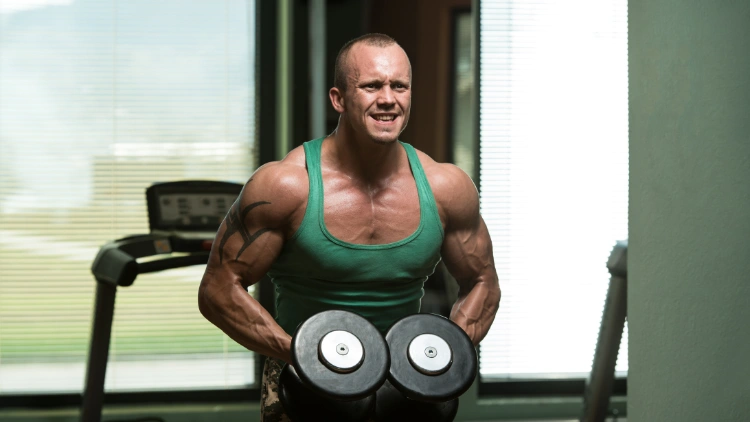
Source: Ibrakovic via Canva.com19
Here are some tips for overcoming poor muscle genetics:
Tailor Your Diet to Your Specific Needs
For those who are trying to get bigger arms, it is important to note that diet is extremely important. While newbie gains are relevant for newer lifters, those who have been lifting for more than a year will find it much more difficult to make gains without having a proper diet.
Research suggests that getting somewhere between .6-.8 grams per pound of bodyweight per day is optimal for long-term muscle growth. This, along with having a diet that includes minimal amounts of processed foods, vegetables, and quality carbs like rice or potatoes, can help muscles to properly heal and grow after hard workouts.
Focus On Progressively Overloading The Arms
Progressive overload has long been known to be the key to getting bigger and stronger, and that very much holds true for the arms.
Both the biceps and triceps respond well to high repetitions, so doing exercises like hammer curls and tricep pushdowns with lower weights and higher reps makes sense. Further than that, as the weeks of training progress, consistently adding weight, reps, or sets to a workout can only benefit a lifter.
At its core, that is what progressive overload is – steadily adding more stress to the muscle while giving it time to recover.
Use Different Exercises and Rep Ranges to Your Advantage
Although higher rep ranges typically receive a better hypertrophic response in the arms, using a lower rep range with heavier weights can also be beneficial. This does not mean to perform heavy sets of tricep pushdowns for 1 to 5 reps – what it means is to use compound movements.
Compound movements, like the guillotine press or the close grip bench press, can load the arms with a significantly heavier weight than isolation exercises can. While the arms will not be the primary mover in compound exercises, they will ultimately receive a heavier stimulus than through any other exercise, which can help to train fast twitch muscle fibers, fibers that prefer heavier weights and lower reps.
For the biceps, the best compound movement to perform for overloading would be the chin-up. The traditional pullup is beneficial for the entire back musculature, forearms, and biceps, but when the arms are supinated, like in the chin-up, the biceps are activated to a higher extent.
Many bodybuilders credit their bicep size from doing high repetitions of an isolation exercise in tandem with lower repetitions of the chin-up, so make sure to incorporate compound movements to holistically train the arms.
Train Arms (Triceps, Biceps and Forearms) to Failure — Also Known as AMRAP (As Many Reps As Possible)
Training to failure is not advocated for on many compound movements like the deadlift or squat because it can be dangerous. But for smaller muscle groups like the biceps and triceps, training to failure, or close to failure, can be extremely effective since these muscles also heal quicker than most.
These muscle groups can take on quite a bit of volume, so when doing high rep sets, performing as many of them as close to failure as possible can help to develop a better mind-muscle connection while also giving ‘the pump’. Getting a pump while training the biceps and triceps not only feels great, but it also delivers a huge amount of blood flow and lactic acid to those muscles, which in turn, will help to develop larger and stronger arms.
An actionable way of training to failure is to first determine the rep range that is ideal for the movement.
For example, when performing the hammer curl, shooting for 10-15 reps is a good idea. Then, pick a weight that makes sense to use, and perform as many reps as possible (AMRAP), until the arms can literally do no more.
If more reps are performed than are in the rep range, the weight can go up. Do this until the proper weight, or the correct weight to use for that rep range, is found.
From here, in future workouts, ensure that each set is performed with this weight and is taken close to failure. Use metrics like RPE, or Rating of Perceived Exertion, to determine how close the individual ‘feels’ they are to failure. This will help to make sure that each set is done with a similar intensity.
Meaning, if an individual feels that they could only have performed two more reps, and they understand how many reps they can do to actual failure, it is a lot more likely that they are performing quality sets.
Focus on Quality Over Quantity
It’s important to focus on quality over quantity. This means that the primary focus should be on doing exercises with perfect form and using heavier weights.
In the long run, this will be much more beneficial than the person who focuses solely on using heavier weights while sacrificing form. Locking in form is key to ensuring proper contractions, and maximizing the recruitment of potential muscle fibers.
One important thing to note is that sleep is important for optimal strength on compound movements, but for single-jointed movements, sleep deprivation doesn’t seem to have too much of an effect.20 Regardless, prioritizing sleep is important.
Train Harder
This is a relative concept that will differ by individual, but in general, the harder a person trains, the more results they will see. This still applies to people with good arm genetics and is especially important for those seeking to jump start weight loss.
Prioritizing proper rest, along with emphasizing intense workouts on non-rest days will allow a person with poor genetics to make the most out of their time in the gym. Without a high level of intensity, there are almost certainly gains being left on the table, which is not the goal.
In fact, one study shows that short-term, intense training of the biceps can have significant increases in strength and neural drive, emphasizing that more intensive training is better.21
Be Patient
Finally, it’s important to be patient when trying to overcome poor muscle genetics. Building muscle takes time, regardless of a person’s genetics.
Consistency is the key here – so often do people switch up their workout routines after a few weeks because they didn’t see immediate results. But this is a massive mistake; especially when a person is genetically disadvantaged when trying to grow muscles, they must be patient.
Poor muscle genetics may make it more difficult to build muscle, but it’s not impossible. Use these tips to help overcome bad arm genetics and build the maximum amount of muscle possible, regardless of if they are small relative to bodybuilding proportion charts.
References
1“How MUSCULAR Can YOU Get Naturally | GOOD vs. BAD Genetics.” YouTube, 14 July 2018. Accessed 5 April 2023. <https://www.youtube.com/watch?v=KneaXp0quCw>
2Kumar, H., Das, S., & Rath, G. (2008). An anatomical insight into the third head of biceps brachii muscle. Bratislava Medical Journal, 109(2), 76-8. <https://pubmed.ncbi.nlm.nih.gov/18457315/>
3Larson, Julia. “Crop unrecognizable sportsman showing bicep in gym.” Canva. Accessed 5 April 2023. <https://www.canva.com/photos/MAES1T8G27M-crop-unrecognizable-sportsman-showing-bicep-in-gym/>
4Verbrugge, S., Schonfelder, M., & Becker, L. (2018). Genes Whose Gain or Loss-Of-Function Increases Skeletal Muscle Mass in Mice: A Systematic Literature Review. Frontiers in Physiology, 9, 553 <https://www.ncbi.nlm.nih.gov/pmc/articles/PMC5992403/>
5Steve Reeves (@stevereeveshercules) • Instagram photos and videos.” Instagram. Accessed 5 April 2023. <https://www.instagram.com/stevereeveshercules/>
6Havill, L., Mahaney, M., & Binkley, T. (2007). Effects of genes, sex, age, and activity on BMC, bone size, and areal and volumetric BMD. Journal of Bone and Mineral Research, 22(5), 737-46. <https://pubmed.ncbi.nlm.nih.gov/17444815/>
7“Do You Have “Good” or “Bad” Muscle-Building Genetics? (5 SIGNS).” YouTube, 25 April 2021. Accessed 5 April 2023. <https://www.youtube.com/watch?v=SD-yAFfLCXg>
8“Am I delusional to see this and hope I can have huge arms with high bicep insertions? : r/bodybuilding.” Reddit, 24 December 2014. Accessed 5 April 2023. <https://www.reddit.com/r/bodybuilding/comments/2q9jpb/am_i_delusional_to_see_this_and_hope_i_can_have/>
9“Uneven Biceps.” AnabolicMinds.com, 17 February 2008. Accessed 5 April 2023. <https://anabolicminds.com/community/threads/uneven-biceps.86334/>
10“I’ll always remember Ronnie like this : r/bodybuilding.” Reddit, 27 March 2018. Accessed 5 April 2023. <https://www.reddit.com/r/bodybuilding/comments/87jhra/ill_always_remember_ronnie_like_this/>
11“The decline of Dexter Jackson’s left arm : r/bodybuilding.” Reddit, 5 May 2020. Accessed 5 April 2023. <https://www.reddit.com/r/bodybuilding/comments/gdxvkk/the_decline_of_dexter_jacksons_left_arm/>
12“Arnold Inspired TRICEPS & BICEPS BEST QUALITY TIPS FOR BIGGER ARMS!” YouTube, 4 November 2018. Accessed 6 April 2023. <https://www.youtube.com/watch?v=AkYzMN73eXc>
13Wavebreakermedia. “Man measuring biceps with tape measure.” Canva. Accessed 5 April 2023. <https://www.canva.com/photos/MADFYLFHWeo-man-measuring-biceps-with-tape-measure/>
14Heaselgrave, S., Blacker, J., Smeuninx, B., McKendry, J., & Breen, L. (2019). Dose-Response Relationship of Weekly Resistance-Training Volume and Frequency on Muscular Adaptations in Trained Men. International Journal of Physiological Performance, 14(3), 360-368 <https://pubmed.ncbi.nlm.nih.gov/30160627/>
15“Long bicep/short tricep vs. short bicep/long tricep : r/bodybuilding.” Reddit, 19 May 2015. Accessed 5 April 2023. <https://www.reddit.com/r/bodybuilding/comments/36grkp/long_bicepshort_tricep_vs_short_biceplong_tricep/>
16“IFBB FIBO Power Pro 2013 – Posing Bodybuilding Johnny Jackson Best Body Nutrition.” YouTube, 19 April 2011. Accessed 6 April 2023. <https://www.youtube.com/watch?v=6dRoBmrbHd8>
17“What can I do to fix uneven triceps? : r/teenfitness.” Reddit, 19 August 2021. Accessed 5 April 2023. <https://www.reddit.com/r/teenfitness/comments/p7hcdh/what_can_i_do_to_fix_uneven_triceps/>
18“Bodybuilder with the best triceps, I nominate Roelly Winklaar : r/bodybuilding.” Reddit, 7 February 2016. Accessed 5 April 2023. <https://www.reddit.com/r/bodybuilding/comments/44o6r1/bodybuilder_with_the_best_triceps_i_nominate/>
19Ibrakovic. “Exercise For Shoulders Dumbbell Lateral Raise.” YouTube. Accessed 5 April 2023. <https://www.canva.com/photos/MADB6k5xiaE-exercise-for-shoulders-dumbbell-lateral-raise/>
20Knowles, O., Drinkwater, E., Urwin, C., Lamon, S., & Aisbett, B. (2018). Inadequate sleep and muscle strength: Implications for resistance training. Journal of Science and Medicine in Sport, 21(9), 959-968. <https://pubmed.ncbi.nlm.nih.gov/29422383/>
21Kidgell, D., Stokes, M., Castricum, T., & Pearce, A. (2010). Neurophysiological responses after short-term strength training of the biceps brachii muscle. Journal of Strength & Conditioning Research, 24(11), 3123-32. <https://pubmed.ncbi.nlm.nih.gov/20881507/>